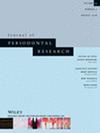CXCL5/CXCL8 induces neutrophilic inflammation in peri-implantitis
Abstract
Objective and Background
This research aimed to examine the role of C-X-C motif chemokine ligand 5 (CXCL5) and C-X-C motif chemokine ligand 8 (CXCL8; also known as IL-8) in neutrophilic inflammation triggered by peri-implantitis and to shed light on the underlying mechanisms that link them to the development of this condition.
Materials
This study included 40 patients who visited the Department of Periodontology at Kyungpook University Dental Hospital. They were divided into two groups based on their condition: healthy implant (HI) group (n = 20) and peri-implantitis (PI) group (n = 20). Biopsy samples of PI tissue were collected from the patients under local anesthesia. HI tissue was obtained using the same method during the second implant surgery. To construct libraries for control and test RNAs, the QuantSeq 3′ mRNA-Seq Library Prep Kit (Lexogen, Inc., Austria) was used according to the manufacturer's instructions. Samples were pooled based on representative cytokines obtained from RNA sequencing results and subjected to Reverse transcription-quantitative polymerase chain reaction (RT-qPCR). Hematoxylin and eosin staining, and immunohistochemistry (IHC) analysis were performed to visually assess expression levels and analyze tissue histology. Student's t-test was employed to conduct statistical analyses.
Results
Initially, heatmaps were used to examine gene expression variations between the HI and PI groups based on the results of RNA sequencing. Notably, among various cytokines, CXCL5 and CXCL8 had the highest expression levels in the PI group compared with the HI group, and they are known to be associated with inflammatory responses. In the gingival tissues, the expression of genes encoding cytokines such as interleukin (IL)-1β, tumor necrosis factor-alpha (TNF)-α, interleukin (IL)-6, and CXCL5/CXCL8 was assessed via RT-qPCR. The mRNA expression level of CXCL5/CXCL8 significantly increased in the PI group compared with the HI group (p < .045). Contrarily, the mRNA expression level of interleukin 36 receptor antagonist (IL36RN) significantly decreased (p < .008). IHC enabled examination of the distribution and intensity of CXCL5/CXCL8 protein expression within the tissue samples. Specifically, increased levels of CXCL5/CXCL8 promote inflammatory responses, cellular proliferation, migration, and invasion within the peri-implant tissues. These effects are mediated through the activation of the PI3K/Akt/NF-κB signaling pathway.
Conclusions
This study found that the PI sites had higher gene expression level of CXCL8/CXCL5 in the soft tissue than HI sites, which could help achieve more accurate diagnosis and treatment planning.

 求助内容:
求助内容: 应助结果提醒方式:
应助结果提醒方式:


